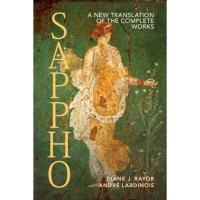
CUP (2023) p/b 200pp £12.99 (ISBN 9781108926973)
There is more to this book than meets the eye. An update of the authors’ 2014 publication, it is not only an attractive translation of every word Sappho may reasonably be credited with composing but also a clear, succinct and judicious review of both of her place in Greek literary history and of what can confidently be said about the circumstances of her songs’ performance.
The trigger for R. and L.’s interest in a revised edition is of course the 2014 publication of two important papyri (P. Sapph. Obbink and P. GC. 105), containing significant fragments of Sappho. They appeared too late for inclusion in the original. (An air of academic skullduggery hangs over their provenance. According to L., ‘In the absence of documentation establishing their legality, the assumption is that [they] were looted’). They were apparently acquired from a mysterious Turkish dealer, and their current location is also unknown. Even so, L. believes that ‘despite the tainted circumstances, we have not seen any evidence that [they] are not authentic’). Rarely are the calm waters of papyrology ruffled by such disturbing breezes.
L.’s 17-page introduction rehearses what can safely be said about Sappho’s life and times. Ancient anecdotes derive mainly from the Suda, an accumulation of conjectures throughout antiquity compiled some sixteen centuries later, for the most part relying on fanciful interpretations of her poetry. Ancient scholars, says L., like modern ones, had a tendency to identify all first-person speakers in Sappho’s poetry with the poet herself and to read her work autobiographically. Indeed, her direct, often passionate expression, so untypical of her times, has especially reinforced her popularity since the Romantic. Hence many later fantasies, especially among 19th century classicists, such as imagining Sappho as the headmistress of a literary academy for girls, complete with slightly steamy undertones of lesbian eroticism. L. comments well on frs. 1 and 31: ‘Sappho seems less concerned with homoerotic desire per se than with the effects of love in general. She illustrates these effects with the example of the desire of the female speaker for a nameless woman, portraying the love of women for other women in a a historically unique way’. Ancient Greeks, on the whole relaxed about male homosexuality, do not seem to have shared later ages’ obsession with female same-sex feelings.
Major, more reliable, sources are, of course, fragmentary citations in Greek and Roman writers, often to illustrate a metrical or grammatical point, and papyri. These often suggest a wider field than homoeroticism, for example wedding songs, cultic hymns, and satirical poems, though it has to be said it was on the first that Sappho’s reputation mainly rested in antiquity. We have to remember that ancient commentators could refer to far more of her works than we can. Moreover, we do not know—and perhaps it doesn’t much matter—whether it was Sappho, a chorus, or another woman who performed her songs, almost certainly on a public occasion.
R. has spent her professional lifetime with Sappho, and has a keen ear for how her Greek can sound effectively in English. Working from Neri’s 2021 edition, which all serious Sapphophiles must now acquire, she aims (as all good translators do) to combine poetry and accuracy, and with very few exceptions she succeeds. She has, she says, added thirty fragments to the previous corpus and has made additions or changes to another seventy by way of adjustments to her 2014 translations. The result is book including every surviving piece of Sappho’s songs, plus twenty-two fragments that can be fairly attributed to her. It is the best version of Sappho this reviewer has seen, scoring heavily on clarity and managing to stay close to the Greek, while more often than not catching the essence of the original. Here are the first three stanzas of fr.1, illustrating both R.’s skill and her habit of revision:
Deathless Aphrodite on your iridescent throne,
wile-weaving daughter of Zeus, I beg you
not to break my spirit, O Queen,
with pain or sorrow
but come—if ever before from far away
you heard my voice and listened,
and leaving your father’s
golden home you came,
your chariot yoked with lovely sparrows
drawing you quickly over the dark earth
in a whirling cloud of wings down
the sky through mid-air.
This is very good. Critical readers will home in on her line 1 rendering of poikilos, impossible to translate simply into English, but ‘iridescent’ is hard to beat, and certainly an improvement in sound, rhythm and accuracy on R.’s previous ‘of many hues’.
A little more tinkering might have helped in fr.130:
Once again Love, that loosener of limbs,
bittersweet and inescapable, crawling thing,
seizes me [2014]
Once again Love, that loosener of limbs,
seizes me—
sweetbitter, inescapable, crawling thing. [2023]
The later version is better; ‘sweetbitter’ works well for glukupikron, but why does R. persist with ‘seizes’ for donei? The Cambridge Greek Lexicon (quoting Sappho in this context) correctly gives ‘shake, stir, excite, agitate’, and anyway the previous line gives the game away describing, Love as lusimeles.
As mentioned above, R. translates pretty well every word of Sappho that exists. Often this must be for scholarly reasons of completeness. Sometimes however a tiny scrap of papyrus can trigger a kind of resonance that invites a different response from that of traditional literary criticism. Freed from the need to fix a poem in its context and judge its literary worth, the reader’s mind is free to follow its own winding path.
...Aphrodite
...[head]...
...loosened.
...for you, [apple] cheeked
...of women
...winds blowing through
...to dance, beautiful Abanthis. [fr.301 Neri]
Shades here of Seferis’s wonderful Asinen te (where admittedly the poet does the wandering for us). Hardly Homer’s or Sappho’s original intention, but somehow also the stuff of poetry.
Professional recordings by Kate Reading of all the poems are freely available at www.cambridge.org/sappho
Anthony Verity
